-
 Bitcoin
Bitcoin $105,953.9980
3.06% -
 Ethereum
Ethereum $2,445.3292
6.68% -
 Tether USDt
Tether USDt $1.0006
-0.03% -
 XRP
XRP $2.1968
7.03% -
 BNB
BNB $643.2903
2.13% -
 Solana
Solana $144.2799
3.82% -
 USDC
USDC $1.0000
-0.03% -
 TRON
TRON $0.2739
0.49% -
 Dogecoin
Dogecoin $0.1642
4.47% -
 Cardano
Cardano $0.5834
5.49% -
 Hyperliquid
Hyperliquid $38.0741
2.80% -
 Sui
Sui $2.7741
7.56% -
 Chainlink
Chainlink $13.4107
11.26% -
 Bitcoin Cash
Bitcoin Cash $450.4828
-0.61% -
 UNUS SED LEO
UNUS SED LEO $9.1301
0.64% -
 Stellar
Stellar $0.2476
5.49% -
 Avalanche
Avalanche $18.0637
5.09% -
 Toncoin
Toncoin $2.9066
2.43% -
 Shiba Inu
Shiba Inu $0.0...01160
4.01% -
 Hedera
Hedera $0.1527
8.00% -
 Litecoin
Litecoin $84.6122
2.37% -
 Monero
Monero $317.6076
5.76% -
 Ethena USDe
Ethena USDe $1.0008
0.02% -
 Polkadot
Polkadot $3.4519
5.27% -
 Dai
Dai $1.0000
-0.03% -
 Bitget Token
Bitget Token $4.2835
5.62% -
 Uniswap
Uniswap $7.0443
9.78% -
 Pepe
Pepe $0.0...09964
7.41% -
 Pi
Pi $0.5391
4.64% -
 Aave
Aave $264.1743
11.26%
Must I clear the position when the weekly KDJ crosses at a high level? Are there differences in different markets?
A high-level weekly KDJ cross in crypto may signal potential bearish momentum, but traders should consider market context, trend strength, and risk tolerance before exiting positions.
Jun 24, 2025 at 10:56 pm
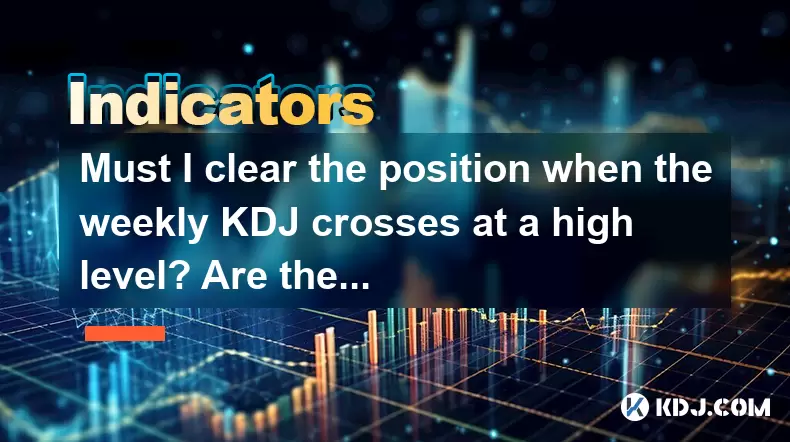
Understanding the Weekly KDJ Indicator
The KDJ indicator, also known as the stochastic oscillator, is a momentum-based technical analysis tool used to identify overbought or oversold conditions in financial markets. It consists of three lines: the %K line (fast stochastic), the %D line (slow stochastic), and the %J line (divergence value). When these lines intersect at a high level on the weekly chart, it often signals potential bearish momentum.
In cryptocurrency trading, the weekly KDJ crossing at a high level is seen by many traders as a possible reversal signal. However, whether one must immediately clear their position depends on several factors including market context, trend strength, and personal risk tolerance.
What Does a High-Level Weekly KDJ Cross Indicate?
When the %K line crosses above the %D line at a high level (typically above 80), it suggests that the asset may be overbought and could experience a pullback. This is especially significant if the cross occurs after a prolonged uptrend.
- Strong resistance levels nearby can amplify this signal.
- High volume during the cross might indicate increased selling pressure.
- Divergence between price and KDJ could confirm weakening momentum.
However, in fast-moving crypto markets, such signals are not always reliable. For example, during strong bull runs, prices can remain overbought for extended periods without immediate correction.
Should You Clear Your Position Immediately?
There's no one-size-fits-all answer. Some traders choose to partially close positions when they see a high-level KDJ cross on the weekly chart, while others wait for additional confirmation from other indicators like RSI or MACD.
Here are some considerations:
- Risk management strategy: Traders with tight stop-loss rules might prefer to exit partially or fully.
- Market sentiment: If overall sentiment remains bullish, the signal may be less compelling.
- Historical performance: In some cryptocurrencies like Bitcoin or Ethereum, high-level KDJ crosses have historically led to corrections, but not always immediately.
It’s crucial to assess your entry point, profit target, and acceptable drawdown before making any decision.
Differences Across Cryptocurrency Markets
Not all cryptocurrencies react the same way to technical indicators. The behavior of altcoins versus major coins like BTC and ETH can differ significantly due to varying liquidity, volatility, and market influence.
- Bitcoin and Ethereum tend to follow broader macroeconomic trends and exhibit more predictable technical behavior.
- Small-cap altcoins can show false KDJ signals due to manipulation or low trading volumes.
- Stablecoins and non-volatile tokens usually don’t generate meaningful KDJ crosses due to lack of price movement.
Therefore, when analyzing a weekly KDJ cross, it’s essential to consider the specific characteristics of the market you're trading.
How to Approach Weekly KDJ Signals in Practice
If you’re using the weekly KDJ to guide your trading decisions, here are actionable steps to consider:
- Verify the timeframe: Ensure you’re looking at the weekly chart and not daily or hourly.
- Check the KDJ parameters: The default setting is often 9-period, but adjustments can affect sensitivity.
- Observe the %J line: A sharp rise or fall in %J may suggest divergence or imminent reversal.
- Combine with support/resistance levels: A KDJ cross near key resistance strengthens the bearish case.
- Use candlestick patterns: Engulfing candles or shooting stars around the cross can enhance the signal.
By integrating multiple tools, you reduce the likelihood of acting on a false signal.
Frequently Asked Questions
Q1: Can I use the weekly KDJ in intraday trading?
No, the weekly KDJ is designed for long-term trend analysis and should not be used directly for short-term or intraday trades. Its signals are slower and meant for strategic positioning rather than quick entries or exits.
Q2: What if the KDJ crosses at a high level but the price keeps rising?
This situation is called a "false signal" or "price continuation". It’s common in strong bull markets where overbought conditions persist. In such cases, trailing stops or dynamic support monitoring becomes more effective than relying solely on KDJ.
Q3: How do I adjust KDJ settings for different cryptocurrencies?
You can experiment with the period length—shorter periods make the indicator more sensitive, longer ones smoother. However, changing settings too frequently can lead to inconsistent results. Stick to a consistent setup across similar assets unless backtesting shows better outcomes with changes.
Q4: Is the weekly KDJ more reliable in bull or bear markets?
The weekly KDJ tends to be more reliable in bear markets or sideways ranges because overbought/oversold signals align more closely with actual reversals. In bull markets, it may give premature sell signals that result in missed gains if not confirmed by other tools.
Disclaimer:info@kdj.com
The information provided is not trading advice. kdj.com does not assume any responsibility for any investments made based on the information provided in this article. Cryptocurrencies are highly volatile and it is highly recommended that you invest with caution after thorough research!
If you believe that the content used on this website infringes your copyright, please contact us immediately (info@kdj.com) and we will delete it promptly.
- Cryptocurrencies: Chart-Breaking Buys Beyond the Hype
- 2025-06-25 04:45:12
- Navigating Crypto Volatility: UNI Price, SUI Token, and the Rise of Unstaked
- 2025-06-25 04:45:12
- Bitcoin, Ethereum, and Geopolitical Tensions: Navigating the Iran-Israel Ceasefire
- 2025-06-25 05:05:13
- JPMorgan, Blockchain, and JPMD Token: A Quantum Leap for On-Chain Finance?
- 2025-06-25 05:05:13
- Chainlink, Mastercard, and Crypto Adoption: Bridging the Gap to Mainstream DeFi
- 2025-06-25 05:44:12
- Hedera Price: Trend Reversal or Downtrend Continuation?
- 2025-06-25 06:05:12
Related knowledge
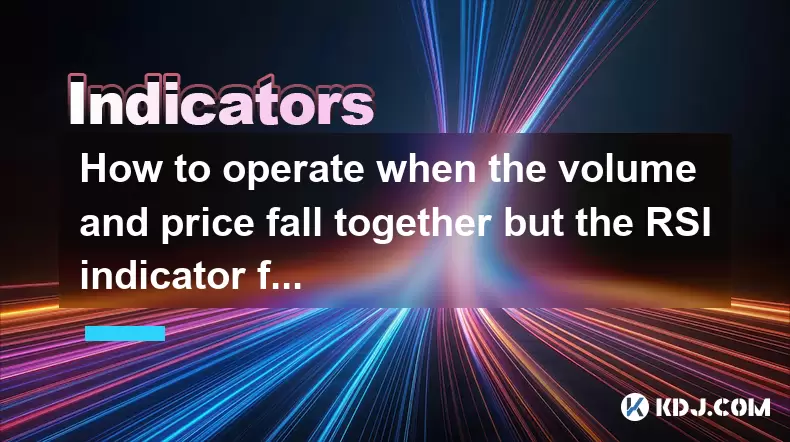
How to operate when the volume and price fall together but the RSI indicator forms a bottom divergence?
Jun 25,2025 at 04:29am
Understanding the Concept of RSI Bottom DivergenceWhen analyzing cryptocurrency price charts, traders often rely on technical indicators to spot potential reversals. One such signal is a bottom divergence in the Relative Strength Index (RSI). This occurs when the price makes a new low, but the RSI does not confirm that low and instead forms a higher low...
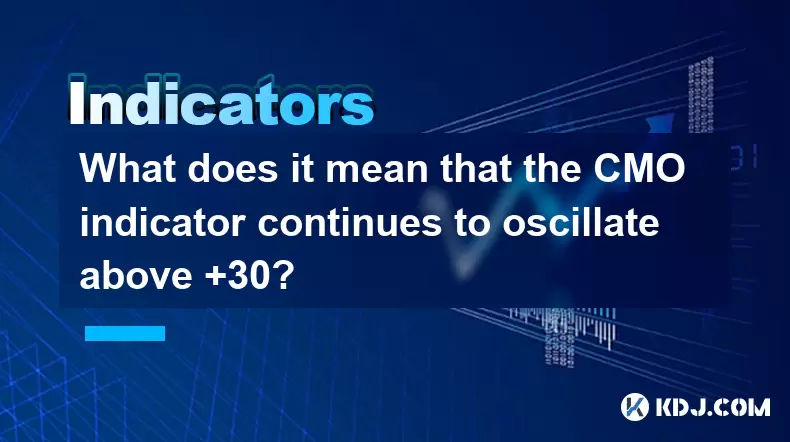
What does it mean that the CMO indicator continues to oscillate above +30?
Jun 25,2025 at 03:29am
Understanding the CMO IndicatorThe Chande Momentum Oscillator (CMO) is a technical analysis tool developed by Tushar Chande to measure momentum in financial markets. In cryptocurrency trading, the CMO helps traders identify overbought or oversold conditions and potential trend reversals. The oscillator ranges from -100 to +100, with values above zero in...

What does it mean that the ATR indicator suddenly doubles after hitting a new low this year?
Jun 24,2025 at 11:57pm
Understanding the ATR IndicatorThe Average True Range (ATR) is a technical analysis indicator used to measure market volatility. Developed by J. Welles Wilder, ATR calculates the average price range between a security’s high and low over a specific period—typically 14 periods. It does not indicate the direction of price movement but rather how volatile ...
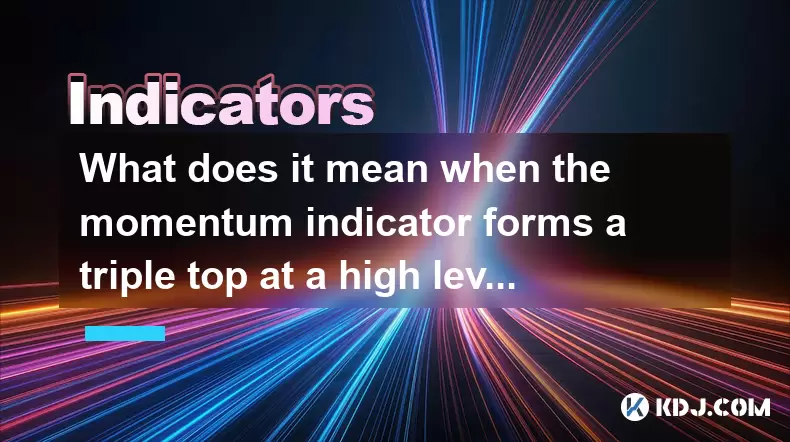
What does it mean when the momentum indicator forms a triple top at a high level?
Jun 25,2025 at 03:15am
Understanding the Momentum Indicator in Cryptocurrency TradingThe momentum indicator is a widely used technical analysis tool that measures the rate of change in price movements over a specified period. In cryptocurrency trading, where volatility is high and trends can reverse rapidly, this indicator helps traders identify potential trend reversals or c...

What does the divergence between the volatility indicator and the price indicate?
Jun 25,2025 at 06:07am
Understanding the Volatility IndicatorThe volatility indicator is a technical analysis tool used to measure the rate and magnitude of price movements in financial markets, including cryptocurrencies. It helps traders assess whether a market is experiencing high or low volatility, which can influence trading decisions. Common types of volatility indicato...
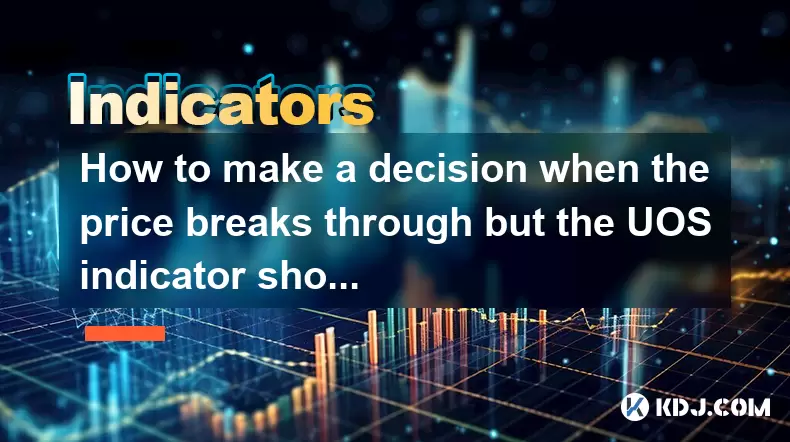
How to make a decision when the price breaks through but the UOS indicator shows a top divergence?
Jun 24,2025 at 11:42pm
Understanding the UOS Indicator and Price BreakthroughsThe Ultimate Oscillator (UOS) is a momentum oscillator that combines multiple timeframes to provide a more accurate picture of market momentum. When traders observe a price breakthrough — where the price moves above a key resistance level — but the UOS indicator shows a top divergence, it creates a ...

How to operate when the volume and price fall together but the RSI indicator forms a bottom divergence?
Jun 25,2025 at 04:29am
Understanding the Concept of RSI Bottom DivergenceWhen analyzing cryptocurrency price charts, traders often rely on technical indicators to spot potential reversals. One such signal is a bottom divergence in the Relative Strength Index (RSI). This occurs when the price makes a new low, but the RSI does not confirm that low and instead forms a higher low...

What does it mean that the CMO indicator continues to oscillate above +30?
Jun 25,2025 at 03:29am
Understanding the CMO IndicatorThe Chande Momentum Oscillator (CMO) is a technical analysis tool developed by Tushar Chande to measure momentum in financial markets. In cryptocurrency trading, the CMO helps traders identify overbought or oversold conditions and potential trend reversals. The oscillator ranges from -100 to +100, with values above zero in...

What does it mean that the ATR indicator suddenly doubles after hitting a new low this year?
Jun 24,2025 at 11:57pm
Understanding the ATR IndicatorThe Average True Range (ATR) is a technical analysis indicator used to measure market volatility. Developed by J. Welles Wilder, ATR calculates the average price range between a security’s high and low over a specific period—typically 14 periods. It does not indicate the direction of price movement but rather how volatile ...

What does it mean when the momentum indicator forms a triple top at a high level?
Jun 25,2025 at 03:15am
Understanding the Momentum Indicator in Cryptocurrency TradingThe momentum indicator is a widely used technical analysis tool that measures the rate of change in price movements over a specified period. In cryptocurrency trading, where volatility is high and trends can reverse rapidly, this indicator helps traders identify potential trend reversals or c...

What does the divergence between the volatility indicator and the price indicate?
Jun 25,2025 at 06:07am
Understanding the Volatility IndicatorThe volatility indicator is a technical analysis tool used to measure the rate and magnitude of price movements in financial markets, including cryptocurrencies. It helps traders assess whether a market is experiencing high or low volatility, which can influence trading decisions. Common types of volatility indicato...

How to make a decision when the price breaks through but the UOS indicator shows a top divergence?
Jun 24,2025 at 11:42pm
Understanding the UOS Indicator and Price BreakthroughsThe Ultimate Oscillator (UOS) is a momentum oscillator that combines multiple timeframes to provide a more accurate picture of market momentum. When traders observe a price breakthrough — where the price moves above a key resistance level — but the UOS indicator shows a top divergence, it creates a ...
See all articles
























































































